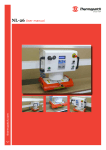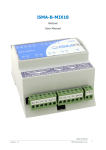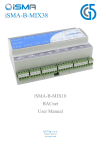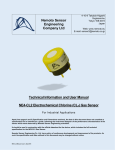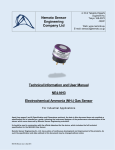Download User manual
Transcript
User Manual: QC-PC-CC-12 Carton contents: 1 controller 1 sensor 1 user manual Technical data: supply voltage: 12V DC power input: <2W 30A Imax. relay: control range: -50°C … +110°C control accuracy: 1°C absolute control sensitivity: 0.1°C 1 Installation Scope 70.5mm 28.5mm Connection one power supply Connection separate power supplies 12 34 78 12 ON 1 2 1 2 Peltier element NTC 10KΩ/ β: 3435K UPel LOCK UIN: 12VDC Ladder Diagram: Front View: 1-2 relay contact Imax = 30A 3-4 supply voltage: 12VDC ON ON v menu lock: 7-8 sensor input 1 2 1 2 NTC 10KΩ/ β: 3435K LOCK UIN: 12VDC v 78 ON Peltier element ON 34 1 2 :8 8.8 ON menu unlock: 1 2 Set Rst Switch ON/OFF: After the activation of the supply voltage, the device is switched on automatically. Holding down RST for approximately 3 seconds switches the device off. Another short actuation switches it on again. Automatic Temperature Display: As long as no malfunction occurs, the device shows the measured temperature value after activation. If during the navigation through the menu no button is hit for about 5 seconds, the display will switch back to this mode of the reference value automatically. All already performed changes are saved immediately. 2 Setting the reference value: If the button Set is hit briefly, the target temperature will be indicated on the display. Through usage of the arrow keys this value can be changed. Adjusting the parameters: The parameters can only be changed if both lock-switches indicate OFF. Activating the menu: Hold down Set for ca. 3 seconds. Use the upward arrow to change to the next menu item and the downward arrow to change to the previous one. Changing the parameters: Select a menu item and hit Set. Use the upward arrow to increase the parameter, the downward arrow to decrease the parameter and change the function, respectively. Parameters: Display Function HC Heating/ Cooling d Hysteresis Reference value -lower limit LS HS CA P7 AH AL Reference value - upper limit Actual temperature offset Activation break Exceeded temperature alarm Deceeded temperature alarm Adjusting Range H/Heating or C/Cooling 1 to 15 Factory Settings Increment C H or C 5 1K -50 to 110 -50 1°C -50 to 110 110 1°C -9 to 9 0 1K 0 to 10 0 1 Minute 0-25 0 1K 0-25 0 1K HC: If the measured temperature is larger than the reference value, the relay contact (1,2) will be opened in the heating mode. If the measured temperature is lower than the reference value, the relay contact (1,2) will be opened in the cooling mode. d: In the heating mode the relay contact closes after actual temperature deceeds the reference value by the value d and opens if the reference value is exceeded. In the cooling mode the relay contact closes after actual temperature exceeds the reference value by the value d and opens if the reference value is deceeded. LS: The lower limit of the reference value determines the smallest selectable reference value. HS: The upper limit of the reference value determines the largest selectable reference value. 3 CA: The measured temperature can be calibrated by the actual temperature offset. P7: The activation break determines the minimum resting time between two switching operations, while the relay contact will be closed. This break is also valid, if the device is switched off or the supply voltage is interrupted. AH: The exceeded temperature alarm determines from which current value above the reference value the display starts to blink. The selection of 0 disables the alarm. AL: The deceeded temperature alarm determines from which current value below the reference value the display starts to blink. The selection of 0 disables the alarm. Error messages: EEE: Sensor not connected, (lead fracture) LLL: Measured temperature below -50°C HHH: Measured temperature above 110°C Hints: The QC-PC-CC-12 is a so-called two position controller. If necessary the heating or cooling is hereby activated or deactivated. Thereby a temperature control can be realized inexpensively. This kind of control is always utilized when an inert feedback control system should be handled, such as in refrigerators or for the tempering of well insulated masses. In such situations a change of the temperature happens rather slow, with the result that after the deactivation, the tempering energy has to be reactivated not before some time has passed. Please consider that the persistence of the peltier element depends on its area of application. Quick-Ohm.de 4






